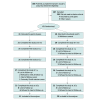Ten-Year Outcomes Following Roux-en-Y Gastric Bypass vs Duodenal Switch for High Body Mass Index: A Randomized Clinical Trial
- PMID: 38829616
- PMCID: PMC11148687
- DOI: 10.1001/jamanetworkopen.2024.14340
Ten-Year Outcomes Following Roux-en-Y Gastric Bypass vs Duodenal Switch for High Body Mass Index: A Randomized Clinical Trial
Abstract
Importance: Results from long-term follow-up after biliopancreatic diversion with duodenal switch (DS) are scarce.
Objective: To compare weight loss, health outcomes, and quality of life 10 years or more after Roux-en-Y-gastric bypass (RYGB) and DS surgery in patients with severe obesity-that is, a body mass index (BMI; calculated as weight in kilograms divided by height in meters squared) of 50 to 60.
Design, setting, and participants: This open-label randomized clinical trial was conducted at 2 academic bariatric centers in Sweden and Norway. Sixty patients with a BMI of 50 to 60 were included from March 1, 2006, to August 31, 2007. Data were analyzed from August 12, 2022, to January 25, 2023.
Interventions: Laparoscopic RYGB or laparoscopic DS.
Main outcomes and measures: The main outcome was change in BMI after 10 or more years. Secondary outcomes included anthropometric measures, lipid and glycemic profiles, bone mass density, adverse events, gastrointestinal tract symptoms, and health-related quality of life.
Results: Forty-eight of the original 60 patients (80%) were assessed after a median of 12 (range, 9-13) years (mean [SD] age, 48.0 [6.0] years; 35 women [73%]). At follow-up, the mean BMI reductions were 11.0 (95% CI, 8.3-13.7) for RYGB and 20.3 (95% CI, 17.6-23.0) for DS, with a mean between-group difference of 9.3 (95% CI, 5.4-13.1; P < .001). Total weight loss was 20.0% (95% CI, 15.3%-24.7%) for RYGB and 33.9% (95% CI, 27.8%-40.0%) for DS (P = .001). Mean serum lipid levels, except high-density lipoprotein cholesterol and hemoglobin A1c, improved more in the DS group during follow-up. Bone mass was reduced for both groups from 5 to 10 years, with lower bone mass after DS at 10 years. Quality-of-life scores (Obesity-Related Problem Scale and the 36-Item Short Form Health Survey) were comparable across groups at 10 years. The total number of adverse events was higher after DS (135 vs 97 for RYGB; P = .02). More patients in the DS group developed vitamin deficiencies (21 vs 11 for RYGB; P = .008) including 25-hydroxyvitamin D deficiency (19 for DS vs 9 for RYGB; P = .005). Four of 29 patients in the DS group (14%) developed severe protein-caloric malnutrition, of whom 3 (10%) underwent revisional surgery.
Conclusions and relevance: In this randomized clinical trial, BMI reduction was greater after DS, but RYGB had a better risk profile over 10 years. Biliopancreatic diversion with DS may not be a better surgical strategy than RYGB for patients with a BMI of 50 to 60.
Trial registration: ClinicalTrials.gov Identifier: NCT00327912.
Conflict of interest statement
Figures



Comment in
-
Metabolic Surgery in Patients With High BMI and Obesity.JAMA Netw Open. 2024 Jun 3;7(6):e2414351. doi: 10.1001/jamanetworkopen.2024.14351. JAMA Netw Open. 2024. PMID: 38829620 No abstract available.
References
-
- Brown WA, Kow L, Shikora S, et al. . 6th IFSO global registry report. 2021. Accessed March 31, 2023. https://www.ifso.com/pdf/ifso-6th-registry-report-2021.pdf

